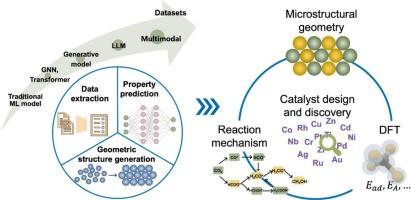大数据驱动的机器学习转化为原子级多相催化剂设计:关键评论
IF 4.3
2区 工程技术
Q2 ENGINEERING, CHEMICAL
引用次数: 0
摘要
机器学习(ML)方法已应用于化学微观结构的研究,例如预测量子特性或生成分子构象。从微观角度看,非均相金属基催化反应包括一系列反应物与催化剂相互作用的基本步骤。多相催化的特异性需要适应最初为分子系统设计的通用ML。人工智能的最新进展在处理跨领域信息方面展示了前所未有的能力。随着大数据驱动催化剂设计的出现,我们综合了最近的进展,确定了差距,并概述了在发现和设计固体非均相催化剂的小规模和大规模数据集上应用ML的挑战。具体而言,我们首先总结和分析了ML模型在预测微观结构性质和通过集成优化算法识别反应机理方面的应用。然后,我们讨论了用于多相催化剂设计的人工智能的最新发展(例如,大型语言模型,生成模型和多模态模型)。本文章由计算机程序翻译,如有差异,请以英文原文为准。


Big data-driven machine learning transformation for atomic-scale heterogeneous catalyst design: a critical review
Machine learning (ML) methods have been applied to the study of chemical microstructures, such as predicting quantum properties or generating molecular conformations. From a microscopic perspective, heterogeneous metal-based catalytic reactions involve a series of elementary steps in which reactants interact with catalysts. The specificity of heterogeneous catalysis necessitates adapting general ML originally designed for molecular systems. Recent advancements in artificial intelligence have demonstrated unprecedented capabilities in processing cross-domain information. With the emergence of big data-driven catalyst design, we synthesize recent progress, identify gaps, and outline challenges in the applications of ML for both small-scale and large-scale datasets in the discovery and design of solid heterogeneous catalysts. Specifically, we first summarize and analyze current applications of ML models in predicting microstructural properties and identifying reaction mechanism by integrating optimization algorithms. We then discuss recent developments in artificial intelligence (e.g., large language models, generative models, and multimodal models) for heterogeneous catalyst design.
求助全文
通过发布文献求助,成功后即可免费获取论文全文。
去求助
来源期刊

Chemical Engineering Science
工程技术-工程:化工
CiteScore
7.50
自引率
8.50%
发文量
1025
审稿时长
50 days
期刊介绍:
Chemical engineering enables the transformation of natural resources and energy into useful products for society. It draws on and applies natural sciences, mathematics and economics, and has developed fundamental engineering science that underpins the discipline.
Chemical Engineering Science (CES) has been publishing papers on the fundamentals of chemical engineering since 1951. CES is the platform where the most significant advances in the discipline have ever since been published. Chemical Engineering Science has accompanied and sustained chemical engineering through its development into the vibrant and broad scientific discipline it is today.
 求助内容:
求助内容: 应助结果提醒方式:
应助结果提醒方式:


